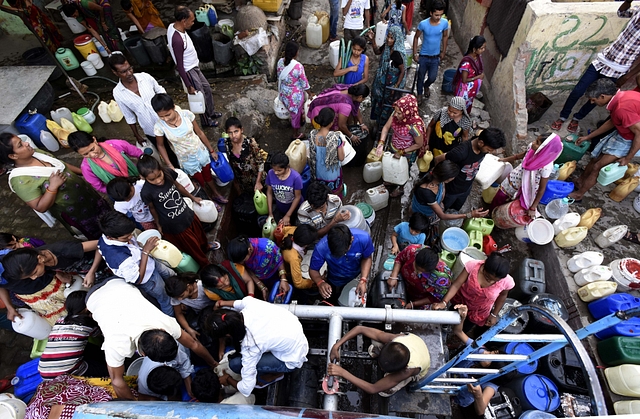
How Delhi Can Pay Its Way Out Of The Water Scarcity
Behavioural approaches can be used to nudge consumers to pay their dues and to conserve scarce water resources.
Simple modifications in what is printed on water bills and when they are delivered could yield significant benefits in water conservation and tariff recovery.
Providing water, sanitation and other essential services to more than 1.6 crore people in Delhi is a major challenge. Government authorities are often blamed for the dismal state of civic amenities in the city. Delhi Jal Board (DJB) is one entity that is often at the receiving end of citizens’ ire with complaints about poor water quality and inadequate supply. While DJB is rightly criticised for tardy state of city’s water infrastructure, some of this criticism maybe misplaced. The DJB is owed an amount of Rs 2,854.80 crore from 1,187,891 consumers in Delhi. These consumer arrears hamstring DJB’s ability to invest in creating better infrastructure or maintaining the existing one.
The challenge is not Delhi’s alone, by 2030, 59 crore people in India will live in cities, up from the 34 crore in 2008. The basic water need per person is 150 litres per day, while the current provision is only 105 litres per person per day in Indian cities. By 2030, this demand would shoot up to 220 litres of water per person per day.
Such capacities would be difficult to achieve, especially when India is predicted to be a water scarce country by 2025. This will cause severe water shortages at the current pace of capacity addition.
This article looks at behavioural insights as a low hanging fruit to help DJB manage the city’s water network better by nudging residents to pay their bills on time and conserve scarce water resources.
Print Price Slab Information On Water Bills To Conserve It
In order to encourage water conservation, water utilities often charge higher prices for higher consumption. However, there is evidence to suggest that if the information about price brackets is unknown or is not salient enough, the consumer’s water demand will be inelastic. Therefore, any price increase to prevent wasteful consumption of water may not translate into a similar decrease in water consumption. Thus rendering block pricing ineffective.
It is anybody’s guess that information about price brackets will help people understand the relation between prices and consumption. In Delhi, there are three price brackets for domestic water consumption 0-20 kilo litre (kl), 20-30 kl and above 30 kl. However, the bill does not convey the volumetric charge for each price block and has no information on the calculation of sewerage charges.
A survey conducted in 10 municipal jurisdictions in Madeira region of Portugal confirmed the suspicion that lack of clarity in water bills interferes with price signaling.
Another study in the United States on the effectiveness of pricing information on water bills reported a 30 per cent increase in price elasticity when the information was made available to the consumers.
The volumetric charge (per kl) in the second bracket i.e. 20-30 kl of monthly consumption is five times the charge in the 0-20 kl category. This steep jump in price could in fact deter people from consuming more water, but in the absence of block pricing information, they may not be sensitive to these prices jumps.
Change To A Monthly Billing Cycle From The Current Quarterly Cycle
In the quarterly bills issued by DJB, water consumption is spread over a period of three months. The consumer doesn’t get information on a monthly basis, which makes it difficult for the consumer to understand their water consumption patterns. An average person plans his/her expenses on a monthly basis; a three-month billing cycle will make it difficult for the individual to factor in water bill in their mental account. As a result, water consumption becomes part of a one off expense that we do not account for when taking decisions about other expenses.
As an illustration, the electricity bill has to be paid every month, as a result the household accounts for the bill in its monthly budget. Whereas, the water bill, to be paid only every three months may not be factored in the mental account for at least two months and people may become careless about their water consumption. Therefore, a reduced salience, lack of information about monthly consumption, and categorisation of water bill as a one time expense in our mental account may lead the individual to be reckless in their use of water.
Leverage Pro-Social Behaviour And Social Comparison For Water Conservation And Bill Payment
When individuals get information about neighbourhood water consumption, it allows them to compare their own water consumption with that of those around them. This information when supplemented with a pro-social message like a smiley face for households that consume less water could make people conscious of their water consumption patterns. Thus nudging them to try and achieve the socially optimal water consumption.
A study that analysed 100,000 residential households in the US found that the impact of technical advice, pro-social message and social comparison led to a 4.8 per cent reduction in water consumption. To put it in perspective, this drop is similar to what would be attained by an average price increase of 12-15 per cent.
Organisation for Economic Co-operation and Development recognises that cost recovery problems in the water sector exist globally and it is difficult to recover full costs exclusively through tariffs. As the debate has shifted from full recovery to sustainable tariff recovery, behavioural approaches can be used to nudge consumers to pay their dues and to conserve scarce water resources.
Simple modifications in what is printed on water bills and when they are delivered could yield significant benefits in water conservation and tariff recovery.
Prateek Sibal studies Economics and Public Policy at Sciences Po, Paris and was a LAMP Fellow 2015-16 at PRS Legislative Research